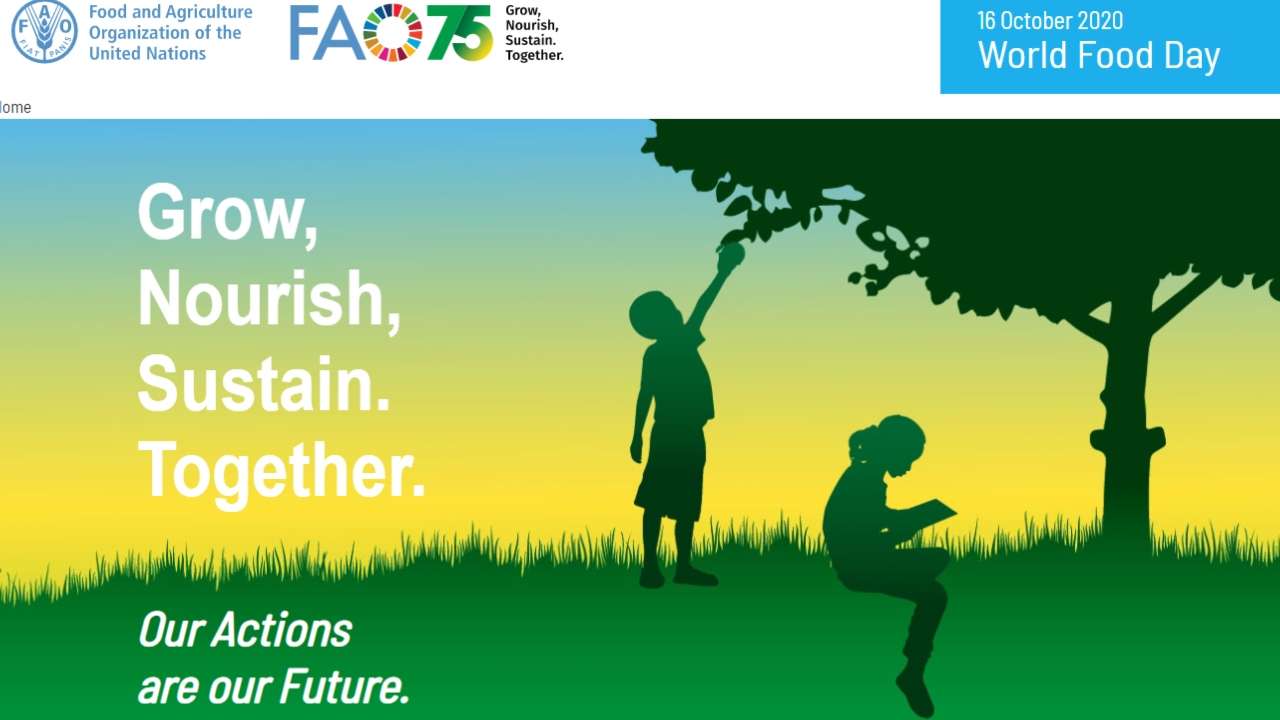This year’s World Food Day theme — “Grow, Nourish, Sustain. Together” meets my favorite standard: it’s clear, finite and confrontable. That’s good, because our current food system and policies are not succeeding in meeting all four of those goals. It is up to all of us to understand and transform those systems and policies. (see UNSCN publication at the bottom of this page).
The prevailing food system grows too much low-nutrition food, in unsustainable ways, and in ways that exacerbate inequality by pricing nutrition-rich food out of the reach of most people (SOFI 2020).
Sustainably and equitably growing affordable nutritious food is a complex human process, and in a time of rapid climate change it is a process that requires constant learning and adaptation – and a profound transformation in gender relations. The people on the front lines of this process are rural women who grow most of the food that people eat, yet continue to be systematically denied access to the information, resources and role in decision-making they need to succeed.
For decades, organizations in the Movement for Community-led Development have listened closely to women farmers and supported their initiatives to transform the system in which they live and produce. We have pioneered systematic methodologies that have proven successful, and we advocate for their widespread adoption.
Taking a queue from the Women’s Empowerment in Agriculture Index, let’s examine five components of women’s deprivation, and how to overcome them.
- Time Poverty: This is perhaps the biggest barrier for women food farmers, as women devote so much of their time to searching for fire wood and water, taking care of the family. They often lack simple tools such as grain mills that could reduce drudgery.
- Leadership: Rural women often live within cultures which denies women any voice in community decision making or roles in governance.
- Agency: Women often lack voice in decision making in both the household and community as to whom to marry, how many children to have, what to grow.
- Income: Most of women’s work is unpaid, and when she does earn income, it is often handed over to the husband. She often lacks access to financial services – one reason microfinance has been women-focused.
- Resources: Women lack equal and secure access to land and farm inputs, and are often assigned more marginal lands than men. Given their family-care responsibilities, they have more need than men to access public services such as health and child care.
We have learned that “silos are sexist” – referring to single sector “siloed” activities. A woman cannot take advantage of business or educational opportunities if she has no time, or has no meaningful access to public services. Only multi sectoral strategies can support women in making progress.
One example of an effective multi sectoral strategy that addresses all five deprivations for women food farmers is the “Epicenter” strategy – created by Africans, for Africans and successfully implemented in 2000 villages across 9 countries across East, West and Southern Africa.
- Freeing Women’s Time: Epicenter communities construct a “one stop” campus that gives women access to health care, child-care, microfinance, agricultural training, drudgery-reducing food processing machinery and a food back all in one location – dramatically reducing time poverty.
- Equal Leadership: All the committees and sector-specific subcommittees of the epicenter have equal leadership by women and men. Many women who’ve developed leadership skills in the epicenter strategy go on to run for elected office in local government.
- Individual and Collective Agency: Epicenters address both gender equality and women’s empowerment. It’s WEP (Women’s Empowerment Program) develops a cohort of WEP Animators who have received in-depth gender training and a passion for transforming entrenched norms and behaviors that hold women back.
- Resources: By being well organized at the sub-district level, epicenters are able to more effectively negotiate for a fair share of public resources, which often do not reach rural areas.
- Incomes: Each epicenter has a rural bank that is run by women. Increasingly, epicenters are also adopting VLS – Village Savings and Loans – for greater collective resource mobilization. Epicenters provide agricultural and vocational training which – unlike most projects – successfully serve more women than men.
Grow and Nourish: Epicenters become a self-reliant, better nourished and more sustainable local food system – with a team of Nutrition Animators and a training farm that promote greater dietary diversity based on locally grown nutrition-rich food. They establish a food bank, which stabilizes the otherwise seasonal fluctuation in food prices, reducing seasonal hunger and indebtedness.
Sustain: Climate Change Adaptation is key for farmers everywhere in the world. During 2019, more than 2,000 Climate Adaptation animators were trained, who delivered climate adaptation capacity development to more than 35,000 participants.
Together: Many development programs focus on individual farmers. Some build the capacity of farmers associations in one value chain or another. The epicenter strategy transforms the economy and social power of everyone in the community – consistent with the 2030 Sustainable Development Goals mantra to “leave no one behind.” Collective power is particularly important to those most at risk of being left behind: women, youth and people with disabilities. Epicenters build on the traditional strengths of African villages and “modernize” them with a strong gender focus and strong links to local government.
Epicenters are not the only model of gender-focused, community-led development in Africa, but it is one that is intentionally transferable. To learn far more about the strategy, visit epicenter toolkit.org.


